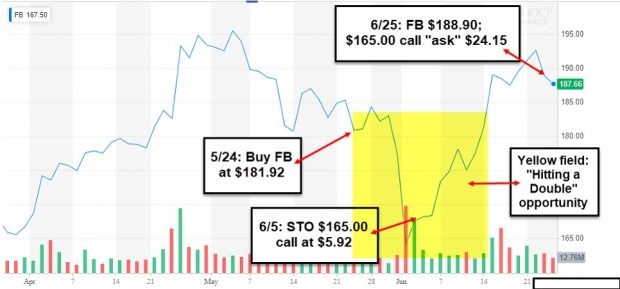Lost opportunity to generate cash with Facebook writes Alan Ellman.
Our covered call options should be sold simultaneously with the purchase of our stocks. If we have evaluated a stock and have a bullish assessment for our covered call portfolio, we next check an option-chain to see if the initial time-value returns meet our goals ( for me, it’s 2% to 4% per month). By waiting to sell an option, share price will likely change and possibly in an unfavorable direction. This, in turn, could eliminate exit strategy opportunities. In June 2019, Mazin shared with me a series of trades he executed with Facebook, Inc. (FB) that highlighted the risk of trades not ideally timed.
Mazin’s trades
- May 24, 2019: Buy FB at $181.92
- June 5, 2019: Sell-to-open the $165.00 at-the-money call (FB price declined to $165.00) for $5.92
- June 25, 2019: FB now trading at $188.90, the cost-to-close the $165.00 call is $24.15
Mazin was considering rolling out-and-up but I want to focus in on a lost opportunity in this article (see chart for Facebook from May to June 2019 below).

When Mazin sold the $165.00 call, a stock loss of $16.92 was locked-in ($181.92 – $165.00). When share value accelerated substantially there was an inclination to re-capture this loss by rolling the option out-and-up. We would now have to pay our hard-earned money to make up for the share loss because the option was sold at a later than ideal date. Let’s assume for the moment that the call option was sold on May 24 when the shares were purchased. Had we sold an at-the-money or out-of-the-money strike, the most likely outcome on June 5, would have been an opportunity to close the short call using our 20%/10% guidelines. A week later, as hare value recovered, the same option could have been re-sold, thereby using our “hitting a double” exit strategy. The yellow field in the screenshot reflects that exit strategy opportunity lost.
What if share price moved up between May 24 and June 5?
In this scenario, we would have benefitted. However, we are adding additional risk to a low-risk strategy. When the share price declined, selling the $165.00 (then) at-the-money strike did generate capital but also locked in a loss. We were playing catch-up” rather than creating opportunities to mitigate losses or enhance gains.
The timing of our covered call trades is a critical aspect to maximizing our returns. When we locate a security that meets our system criteria and our initial time-value return goals are met, share purchase and option sale should be executed simultaneously. This will eliminate the risk of share value decline and having to sell a lower strike which may lock in a loss on the stock side.
Use the multiple tab of the Ellman Calculator to calculate initial option returns (ROO), upside potential (for out-of-the-money strikes) and downside protection (for in-the-money strikes). The breakeven price point is also calculated. For more information on the PCP strategy and put-selling trade management click here and here.





















